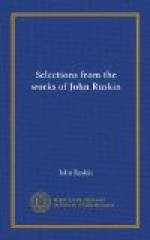[30] Some sentences of an argumentative
nature have been omitted from
this selection.
[31] A mythical island in the Atlantic.
[32] I have often seen the white, thin,
morning cloud, edged with
the seven colours of the prism. I
am not aware of the cause of this
phenomenon, for it takes place not when
we stand with our backs to
the sun, but in clouds near the sun itself,
irregularly and over
indefinite spaces, sometimes taking place
in the body of the cloud.
The colours are distinct and vivid, but
have a kind of metallic
lustre upon them. [Ruskin.]
[33] Lake Lucerne. [Ruskin.]
[34] The implication is that Turner has best delivered it.
THE GRAND STYLE[35]
VOLUME III, CHAPTER I
In taking up the clue of an inquiry, now intermitted for nearly ten years, it may be well to do as a traveller would, who had to recommence an interrupted journey in a guideless country; and, ascending, as it were, some little hill beside our road, note how far we have already advanced, and what pleasantest ways we may choose for farther progress.
I endeavoured, in the beginning of the first volume, to divide the sources of pleasure open to us in Art into certain groups, which might conveniently be studied in succession. After some preliminary discussion, it was concluded that these groups were, in the main, three; consisting, first, of the pleasures taken in perceiving simple resemblance to Nature (Ideas of Truth); secondly, of the pleasures taken in the beauty of the things chosen to be painted (Ideas of Beauty); and, lastly, of pleasures taken in the meanings and relations of these things (Ideas of Relation).
The first volume, treating of the ideas of Truth, was chiefly occupied with an inquiry into the various success with which different artists had represented the facts of Nature,—an inquiry necessarily conducted very imperfectly, owing to the want of pictorial illustration.
The second volume merely opened the inquiry into the nature of ideas of Beauty and Relation, by analysing (as far as I was able to do so) the two faculties of the human mind which mainly seized such ideas; namely, the contemplative and imaginative faculties.




